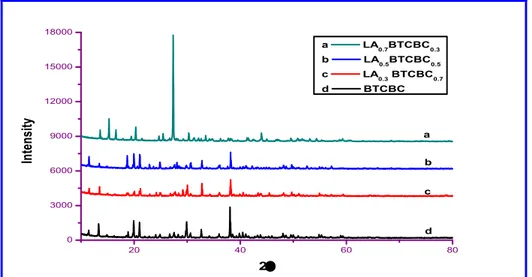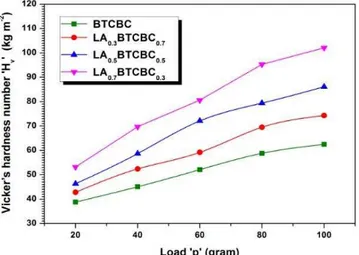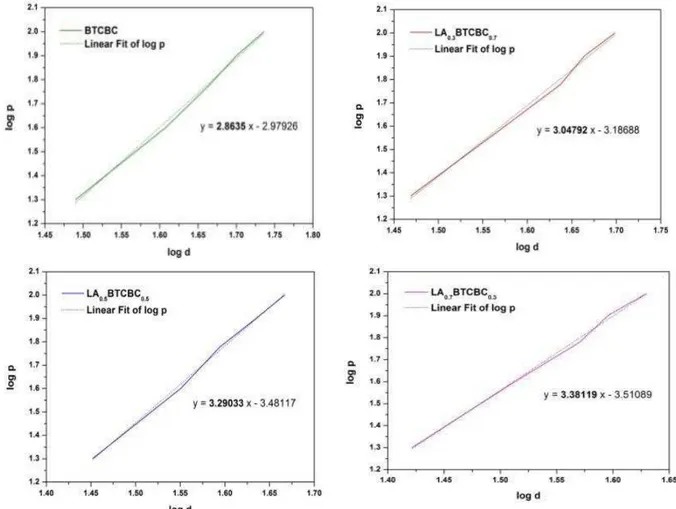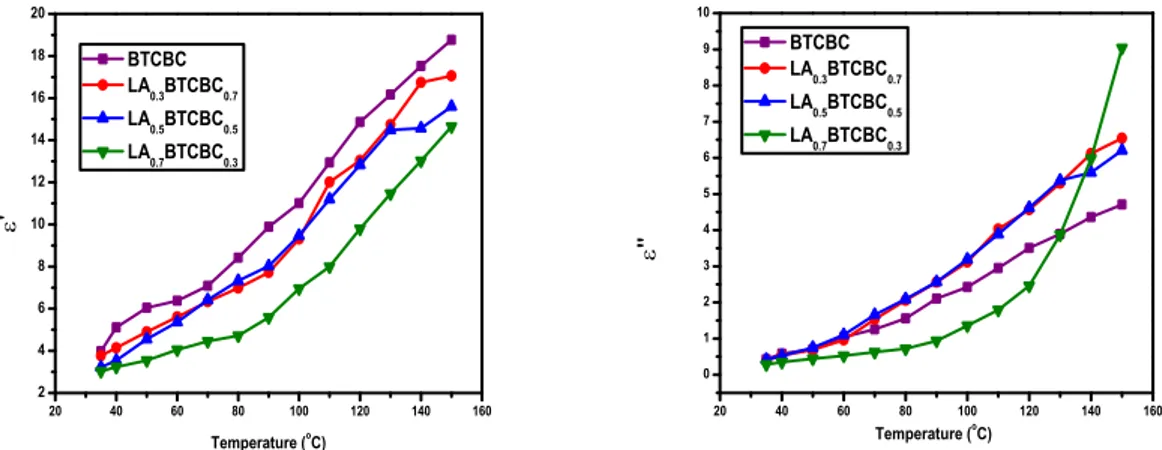Investigation on the Growth and Physio-Chemical Properties of
L-Alanine Mixed BTCBC Single Crystals
P. Sivakala
a,*, N. Joseph John
band S. Perumal
caDepartment of Physics, Udaya School of Engineering, Vellamodi – 629 204, India bDepartment of Physics, Government Arts College, Ooty, Nilgris– 643 002, India cPhysics Research Centre , S.T.Hindu College, Nagercoil-629004, India
ABSTRACT
Pure and L-alanine an aminoacid mixed bisthiourea cadmium bromide chloride single crystals were grown by slow evaporation technique. A drastic change in morphology was inferred with the concentration of L-alanine. Mixed crystals have better optical transparency as well as NLO efficiency than the pure BTCBC which were imperative for nonlinear applications. Also L-alanine mixing increases the hardness. The AC conductivity of the grown crystals increases with increasing concentration of L-alanine.
I.
INTRODCUTION
Nonlinear optical materials will be the key elements for future photonic technologies based on the fact that photons are capable of processing information with the speed of light. Researchers have been searching for new and efficient NLO materials since SHG was first observed in single crystals of
quartz by Franken et al in 1961[1]. In the beginning,
studies were concentrated on inorganic materials such as quartz, potassium dihydrogen phosphate
(KDP), lithium niobate (LiNbO3) and semiconductors
such as cadmium sulfide, selenium, and tellurium. Inorganic materials are much more matured in their application to second order NLO materials than organics. Most commercial materials are inorganic especially for high power use. However, organic materials are perceived as being structurally more diverse and therefore are believed to have more long term promise than inorganics.
Recent interest is concentrated on metal complexes of organic compounds owing to their large
nonlinearity [2]. The - conjugated network, in
organic system with large nonlinearity, has significant absorption in the visible region. Hence for second harmonic generation (SHG) in the blue-near-UV region, more transparent and less extensively delocalized organics like urea or its analogs have
been considered [2]. Thiourea is one such organic
system. It is nearly coplanar in structure and is a resonant hybrid of three resonance structures with
each contributing roughly an equal amount. The
-orbital electron delocalization in thiourea that arises from the mesomeric effect is responsible for their nonlinear optical response and the absorption in the near ultraviolet region. Growth of organometallic single crystals has been a subject of perennial concern in order to use these materials for device
application. Crystals of the type M[TU]2X2 where
M=Cd, Co, Hg, Pb, Ti and Zn, Cu, TU is thiourea and X is a halogen, has been found to exhibit good
NLO properties [3-4]. The nonlinear optical
properties of some of the complexes of thiourea, such as bis thiourea cadmium chloride (BTCC), bis thiourea zinc chloride (BTZC), tris thiourea zinc sulphate (ZTS), tris thiourea cadmium sulphate (CTS), potassium thiourea bromide (PTB) have gained significant attention in the last few years
[3,5,6], because both organic and inorganic components in it contribute specifically to the process of second harmonic generation. The centrosymmetric thiourea molecule, when combine with inorganic salt yield noncentrosymmetric complexes, which has the
nonlinear optical properties [7]. Hence, in several
years, search is focused on new types NLO materials which combined the advantages of organic and inorganic material called semiorganic materials.
The amino acids are the famous organic materials. Play a vitol role in the field of nonlinear optical crystal growth. Many members of natural amino acids individually exhibiting the nonlinear
optical properties because they have a donor NH2 and
acceptor COOH group and the intermolecular charge transfer is also possible. Especially natural amino
acids such as Arginine, alanine, lysine and γ glycine
are evidently showing NLO property because of
additional COOH group in first and NH2 group in
second. Therefore mixing of amino acid with already
known organic, inorganic or semi-organic NLO materials may improve their NLO and ferroelectric properties. The literature survey confirmed the studies on improved second harmonic generation, thermal, and opto-electric properties of crystals grown by mixing equimolar ratios of amino acids L-alanine, L-arginine with malic acid, oxalic acid and
nitric acid and acetic acid [8-12]. Usha et al.[13]
reported that the comparatively high optical
25 30 35 40 45 50 10
20 30 40 50 60 70 80
S
o
lu
b
il
it
y
(
g
m
/
1
0
0
m
l)
Temperature (oC) BTCBC
LA0.3BTCBC0.7
LA0.5BTCBC0.5 LA0.7BTCBC0.3
nonlinearity comes from the distortion of the tetrahedron, which is composed of three allyl thiourea and one Cl or Br combining with the metal
atoms Cd2+ or Hg2+. The distorted tetrahedron
arrangement in the material increases the asymmetric structure and hence contributes to the enhanced NLO activity. Based on the above knowledge, in our present study, an attempt has been made to grow single crystals of L-alanine mixed Bis thiourea cadmium bromide chloride [BTCBC] single crystals in different molar ratios.
II.
MATERIALS AND METHODS
2.1 Synthesis of BTCBC
Saturated solution of thiourea was made by dissolving 4.0g of AR grade thiourea in 25ml of double distilled water. 9.2 g AR grade cadmium chloride and 5.0 g of AR of ammonium bromide were dissolved in 40ml of hot water (45ºC). This solution was added slowly in the saturated solution of thiourea under continues stirring. This mixture solution was stirred well to get a clear solution. The
solution was purified by repeated filtration. The filtered solution was kept for free evaporation .After 3 days, tiny crystals of BTCBC was obtained according to the following reaction:
2[CS (NH2)2] + NH4Br+CdCl2→2Cd [CS (ζH2)2]2
BrCl + NH4Cl
Repeated recrystallization process was carried out in order to eliminate impurities in the BTCBC crystal.
2.2 GROWTH OF L-ALANINE MIXED BTCBC SINGLE CRYSTALS
L-alanine mixed BTCBC crystals (LABTCBC) were grown by taking L-alanine and BTCBC in 3 different molar ratios viz., 0.3:0.7, 0.5:0.5 and 0.7:0.3. The supersaturated solution was prepared by
using the solubility curve given in Fig.1a. Good
quality single crystals were obtained after 20 days. The photograph of the grown crystals was shown in
Fig. 1b.
Figure 1: (a) Solubility curve; (b) (from left to right) Photograph of BTCBC; LA0.3BTCBC0.7; LA0.5BTCBC0.5;
and LA0.7BTCBC0.3 single crystals.
2.3 Characterizations made
The single crystal X-ray diffraction studies of the
grown crystals were carried out using Bruker Nonius
APEX II - V2.D2 single crystal X-ray diffractometer
with MoKα ( = 0.717 Å) radiation. The optical
transmittance spectrum was recorded in the range of
190-1200 nm, using Cary 500 scan UV-Vis-NIR
spectrometer. The NLO test of BTCBC and LABTCBC crystals were evaluated by the Kurtz and
Perry powder technique [14] using a Q-switched,
mode locked ζd μ YAG laser emitting 1.06 m, 8 ns
laser pulses with spot radius of 1 mm. Microhardness studies have been carried out using a
MMT-X7B MATSUZAWA CO., Ltd. The applied load was varied from 5 to 100 g with a constant indentation time of 15 seconds in each case. The hardness profile was studied by plotting the variation
of hardness number (HV) with applied load (P). The
temperature dependent capacitance (C) and dielectric
loss factor (tan ) measurements were carried out on
the prepared crystals an accuracy of ± 1 % with
Agilent 4284 A LCR Meter in the temperature range
of 40 – 150 °C at 1kHz frequency. The observations
were made while cooling the sample by using the
conventional two-probe technique [15]. Temperature
was controlled to an accuracy level of ± 1 ºC. The air capacitance (Cair) in between the two electrodes was
also measured.
III.
RESULTS OBTAINED
3.1 Single crystal XRD Analysis
The single crystal XRD data of the pure and
L-alanine mixed BTCBC crystals are presented in Table
1. With increasing concentration of L-alanine, the
crystal system changed from orthorhombic to tetragonal structure which confirms the formation of mixed crystals. Also the result resembles the XRD
studies of L-alanine mixed BTCB crystals [16].
1a
Table 1 : Single crystal XRD data of Pure L-alanine mixed BTCBC single crystals
BTCBC LA0.3BTCBC0.7 LA0.5BTCBC0.5 LA0.7BTCBC0.3
system Orthorhombic Orthorhombic Orthorhombic Tetragonal
a Å 5.782 6.023 6.232 6.841
b Å 6.640 6.854 7.184 6.841
c Å 7.932 8.125 8.548 11.12
V Å3 304.52 335.41 385.73 520.40
3.2 Powder XRD Analysis
The PXRD patterns obtained in the present study
are shown in Fig. 2. The lattice parameters have been
calculated by unit cell software package and given in
Table 2. For the maximum concentration of L-alanine, the crystal system of the mixed crystal
changes orthorhombic to tetragonal, this favours the formation of mixed crystals. Also the results of PXRD agreed well with that of single crystal XRD data.
20 40 60 80
0 3000 6000 9000 12000 15000 18000
d c b a
2
a LA0.7BTCBC0.3
b LA0.5BTCBC0.5
c LA
0.3 BTCBC0.7
d BTCBC
In
te
n
si
ty
Figure 2: PXRD patterns of pure and L-alanine mixed BTCBC single crystals
Tab2: Unit Cell Parameters from PXRD
3.3Optical absorption spectrum Analysis
The absorption spectrum of pure BTCBC and l-alanine mixed BTCBC were recorded using UV-Vis-NIR spectrophotometer in the range from 190nm to 1100nm using Cary 500 scan UV-Vis-NIR
spectrometer and it is shown in Fig. 3. The crystal
shows a good transmittance in the visible region which enables it to be a good material for optoelectronic applications. As observed in the spectrum, the pure BTCB crystal was transparent in
the region from 269 nm to 1100nm and LABTCB was transparent in the region from 259 nm to 1100 nm. The lower cut off wavelength for pure BTCB is found at 269 nm and the lower cut off wavelength for LABTCB is found at 259 nm. The wide range of transparency suggests that the crystals are good candidates for nonlinear optical applications. The shift of lower cutoff wavelength in UV region is due to mixing of L-alanine and is desirable for optoelectronic application.
BTCBC LA0.3 BTCBC0.7 LA0.5 BTCBC0.5 LA0.7 BTCBC0.3
system Orthorhombic Orthorhombic Orthorhombic Tetragonal
a Å 5.8949 6.123 6.451 6.856
b Å 6.651 6.941 7.232 6.856
c Å 7.937 8.352 9.365 11.25
Figure 3: UV transmittance and taue plot for pure and l-alanine mixed BTCBC single crystals
1.4 NLO studies
The second harmonic generation test was carried out by classical powder method developed by Kurtz
and Perry [14]. It is an important and popular tool to
evaluate the conversion efficiency of NLO materials. The fundamental beam of 1064 nm from Q switched Nd: YAG laser was used to test the second harmonic generation (SHG) property of pure BTCB and LABTCB crystals. Pulse energy 2.9 mJ/pulse and pulse width 8 ns with a repetition rate of 10 Hz were used. The input laser beam was passed through an IR
detector and then directed on the microcrystalline powdered sample packed in a capillary tube. The SHG signal generated in the sample was confirmed from emission of green radiation from the sample. KDP and urea crystals were powdered to the identical size and were used as reference materials in the SHG measurement. L-alanine addition increases the SHG efficiency by 1.36 times than KDP this may be due to increases of noncentrosymmetry with the addition of alanine. SHG efficiency of the pure and l-alanine
mixed crystals are given in Table 3.
Table 3 : SHG efficiency of pure and L-alanine mixed BTCBC single crystals
Name Output mJ SHG efficiency ( compared to KDP)
BTCBC 53.2 1.003 times
LA0.3BTCBC0.7 68.4 1.291
LA0.5BTCBC0.5 72.1 1.360
LA0.7BTCBC0.3 65.3 1.232
3.5 Micro hardness studies
Fig. 4 shows variation of Hv as a function of applied load ranging from 20 to 100 g for pure and
L-alanine mixed BTCBC single crystals. It is very clear
from the figure that Hv increases with increase in
load and with increasing concentration of L-alanine. This may be explained as follows: In the solid state L-alanine exists as zwitterions. So introduction of
L-alanine in the crystal lattice of BTCBC creates ionic vacancy. All these defects, act as obstacles to dislocation motion, thus increasing the hardness of the crystals. At higher concentration of impurity, the impurity-vacancy associates into larger aggregate. So, hardness saturates at higher concentration of impurity.
εeyer’s index number was calculated from
εeyer’s law [17] which relates the load and
indentation diagonal length as P = kdn,
log P = log k + n log d,
where k is the material constant and ‘n’ the εeyer’s
index. The above relation indicates that Hv should
increase with P, if n > 2 and decrease with P when n < 2. This is well satisfied as shown by Fig.4. εeyer’s
index number ‘n’ was calculated from the slope of
the graph log d vs log p and given in Fig. 5.
According to Hanneman [18], the values of n
were 1–1·6 for hard materials and more than 1·6 for soft ones. Therefore from the graph it is clear that all the grown crystals belong to soft category.
Figure 5: Log d vs log P graph for pure and L-alanine mixed BTCBC single crystals
3.6 Electrical Analysis
Dielectric measurements were made following the methods adopted by Mahadevan and his
co-workers [19-20] at various temperatures ranging from
35-150oC with fixed frequency 1 kHz using a Agilent
4284 A LCR meter. The observations were made while cooling the sample. The dimensions of the crystals were measured using a travelling
microscope. Air capacitance (Cair) was also
measured. The crystals were shaped and polished and the opposite faces were coated with graphite to form a good ohmic contact.
As the crystal area was smaller than the plate area of the cell, the real part of the dielectric constant
was estimated using εahadevan’s relation [20]
' = [Aair/Acry][Ccry– (Cair (1-Acry/Aair))/Cair]
where Ccry is the capacitance with crystal (including
air), Cair is the capacitance of air, Acry, is the area of
the crystal touching the electrode and Aair is the area
of the electrode. The imaginary part of the dielectric
constant ( '') was calculated with the measured
dielectric loss factor (tan ) using the relation '' = ’ tan
The AC electrical conductivity (ζac) was calculated
using the relation
ac = o ω tan
Where ois the permittivity of free space (8.85 x 10
-12
C2N-1m-2) and ω is the angular frequency (ω = 2πf ; f is the frequency of the applied electric field).
20 40 60 80 100 120 140 160 2 4 6 8 10 12 14 16 18 20 BTCBC LA0.3BTCBC0.7 LA0.5BTCBC0.5 LA
0.7BTCBC0.3
'
Temperature (oC)
20 40 60 80 100 120 140 160
0 1 2 3 4 5 6 7 8 9 10 BTCBC LA0.3BTCBC0.7 LA
0.5BTCBC0.5
LA0.7BTCBC0.3
''
Temperature (o
C)
Figure 6:Variation of ’ and ” with temperature for pure and δ-alanine mixed BTCBC single
crystals
20 40 60 80 100 120 140 160
0.1 0.2 0.3 0.4 0.5 0.6 0.7 BTCBC LA0.3BTCBC0.7
LA0.5BTCBC0.5
LA0.7BTCBC0.3
ta
n
Temperature (oC)
20 40 60 80 100 120 140 160
0.0 0.5 1.0 1.5 2.0 2.5 3.0 3.5 4.0 4.5 5.0 5.5 BTCBC LA0.3BTCBC0.7
LA0.5BTCBC0.5
LA0.7BTCBC0.3
Temperature (oC)
ac x 1 0 -7 ( m h o /m )
Figure 7: Variation of loss factor and Ac conductivity with temperature for pure and L-alanine
mixed BTCBC single crystals
These plots exemplify the fact that the dielectric constant and the dielectric loss and AC conductivity are directly proportional to the temperature. This is a
normal dielectric behaviour [21]. Dielectric
properties are correlated with the electro-optic
property of the crystals [22]. The higher values of
dielectric loss (tan ) and dielectric constant observed
at lower frequencies may be attributed to space charge polarization owing to charged lattice defects
[23]. The considerable low value of dielectric
constants observed for the grown crystals is important for extending the material applications towards photonic, electro-optic and NLO devices. Moreover, the low dielectric losses observed indicates that the crystals grown in the present study are of good quality. The temperature dependence of AC electrical conductivity and dielectric constant can be explained as due to the temperature dependence of protonic movement and ionic polarizability respectively.
IV.
Conclusions
Pure and L-alanine mixed BTCBC single crystals were successfully grown by slow evaporation techniques. At the maximum Concentration of L-alanine changes the crystal structure to tetragonal system. Also L-alanine mixing in different molar ratio tunes the optical band gap of BTCBC crystals up to 4.34 eV which was used to scrutinize the electronic band structure highly demanded for
optoelectronics applications. Also La0.5BTCBC0.5
exhibit maximum SHG efficiency. L-alanine addition
increases hardness due to ionic vacancy. A result of
References
[1] Franken P.A., Hill A., Peters C.W. and
Weinrich G. (1961), Phys. Rev. Lett., Vol. 7,
pp. 118.
[2] Newmann , L. F. Warren, P. Cunningham,
T. Y. Chang, Materials Research Society Symposium Proceedings (1990) 557.
[3] G. Xing, M. Jiang, Z. Shao and D. Xu, Chin.
(1987) J. Lasers 14, 302
[4] M. Quassaid, P. Becker, C. Carabatos
Nedelec, (1998) Phys. Stat. Sol. 207(b) ,499.
[5] H.O.Marcy, L.F.Warren, M.S.Hebb,
C.A.Ebbers, S.P.Visko, C.G.Kennedy,
(1992) J. Appl.Opt. 31 , 5051.
[6] M.Oussaid, P.Becker, Kemiche, M. C.
Carabatos -Nedlec, (1998) Phs. Stat. Sol.B 207, 103.
[7] S.Anie Roshan, C.Joseph, M.A.Ittachen,
(2001) Matter.Lett.49, 299.
[8] Martin Britto Dhas, S.A.,
Bhagavannarayana, G. Natarajan, S., (2008). The open crystallography Journal, Vol.1.
[9] U.Karunanithi, , S.Arulmozhi, , J.Madhavan,
(2012), Journal of Appied Physics, Vol. 1.
[10] R.Mohan Kumara., D.Rajan Babu,
D.Jayaraman, R.Jayavel, K.Kitamura.,
(2005). Journal of Crystal Growth, Vol.3, 275.
[11] K. J.Arun, S.Jayalekshmi, (2009). Journal of
Mineral Materials Characterisation & Engineering,Vol. 8,12
[12] P.Praveen Kumar, V.Manivannan,
P.Sagayaraj, J. Madhavan, (2009) Bulletin of Material Science, Vol. 32.,1857
.
[13]R. Josephine Usha, J. Arul Martin Mani, P.
Sagayaraj and V. Joseph,( 2012) Archives of
Applied Science Research, , 4
(3):1266-1273.
[14]Kurtz S.K. and Perry T.T., (1968) J. Appl.
Phys. Vol 39, pp 3798
[15] M. Meena and C.K. Mahadevan, Cryst. Res.
Technol.(2008) 43, 166-172
[16] M.Senthilkumar and C.Ramachandraraja,
Journal of Minerals & Materials Characterization & Engineering, Vol. 11,
No.6, pp.631-639, 2012.
[17] Jagannathan K, Kalainathan S, and
Gnasekaran T(2007) Mater.Lett.61, 4485.
[18] Hanneman M(1941) Metall.Manchu 23,135
[19] N .Joseph John and C.K Mahadevan (2008)
Materials & Manf. Proces. 23, 809-814.
[20] N.Joseph John, P .Selvarajan, Benita Jeba
Silviya and C.K Mahadevan (2007) Materials & Manf. Proces. 22, 379-384. [21] J.C.Anderson, ‘Dielectrics’, Chapman and
Hall, London 1964 .
[22] S.Boomadevi and R.Dhanasekaran, (2004)
Journal of Crystal Growth, Vol. 261, pp. 70-76.
[23] A.Vasudevan, S.Carin, M.R. Melloch and




